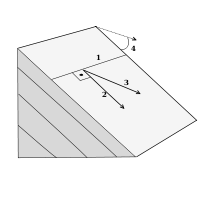Strike and dip

Strike and dip refer to the orientation or attitude of a geologic feature. The strike line of a bed, fault, or other planar feature, is a line representing the intersection of that feature with a horizontal plane. On a geologic map, this is represented with a short straight line segment oriented parallel to the strike line. Strike (or strike angle) can be given as either a quadrant compass bearing of the strike line (N25°E for example) or in terms of east or west of true north or south, a single three digit number representing the azimuth, where the lower number is usually given (where the example of N25°E would simply be 025), or the azimuth number followed by the degree sign (example of N25°E would be 025°).
The dip gives the steepest angle of descent of a tilted bed or feature relative to a horizontal plane, and is given by the number (0°-90°) as well as a letter (N,S,E,W) with rough direction in which the bed is dipping downwards. One technique is to always take the strike so the dip is 90° to the right of the strike, in which case the redundant letter following the dip angle is omitted (right hand rule, or RHR). The map symbol is a short line attached and at right angles to the strike symbol pointing in the direction which the planar surface is dipping down. The angle of dip is generally included on a geologic map without the degree sign. Beds that are dipping vertically are shown with the dip symbol on both sides of the strike, and beds that are flat are shown like the vertical beds, but with a circle around them. Both vertical and flat beds do not have a number written with them.


Another way of representing strike and dip is by dip and dip direction. The dip direction is the azimuth of the direction the dip as projected to the horizontal (like the trend of a linear feature in trend and plunge measurements), which is 90° off the strike angle. For example, a bed dipping 30° to the South, would have an East-West strike (and would be written 090°/30° S using strike and dip), but would be written as 30/180 using the dip and dip direction method.
Strike and dip are determined in the field with a compass and clinometer or a combination of the two, such as a Brunton compass named after D.W. Brunton, a Colorado miner. Compass-clinometers which measure dip and dip direction in a single operation (as pictured) are often called "stratum" or "Klar" compasses after a German professor. Smartphone apps are also now available, that make use of the internal accelerometer to provide orientation measurements. Combined with the GPS functionality of such devices, this allows readings to be recorded and later downloaded onto a map.[1]
Any planar feature can be described by strike and dip. This includes sedimentary bedding, faults and fractures, cuestas, igneous dikes and sills, metamorphic foliation and any other planar feature in the Earth. Linear features are measured with very similar methods, where "plunge" is the dip angle and "trend" is analogous to the dip direction value.
Apparent dip is the name of any dip measured in a vertical plane that is not perpendicular to the strike line. True dip can be calculated from apparent dip using trigonometry if you know the strike. Geologic cross sections use apparent dip when they are drawn at some angle not perpendicular to strike.
Notes
- ↑ Weng Y.-H., Sun F.-S. & Grigsby J.D. (2012). "GeoTools: An android phone application in geology". Computers & Geosciences 44: 24–30. doi:10.1016/j.cageo.2012.02.027.
References
- Compton, Robert R. (1985). Geology in the Field. New York: J. Wiley and Sons. ISBN 978-0-471-82902-7. OCLC 301031779.
- Lahee, Frederic Henry (1961) [1916]. Field Geology (6th ed.). New York: McGraw-Hill. OCLC 500832981.
- Tarbuck, Edward J.; Lutgens, Frederick K. (2008). 0-13-092025-8 Earth: An Introduction to Physical Geology Check
|url= - "Digital Cartographic Standard for Geologic Map Symbolization". FGDC Geological Data Subcommittee. USGS. August 2006. Retrieved 20 March 2010.
External links
-
 "Dip". New International Encyclopedia. 1905.
"Dip". New International Encyclopedia. 1905.